If you’re gearing up for a job that involves hauling materials, you might be wondering what construction equipment to use. There are many types of equipment to choose from, each specialized for specific types of jobs, jobsites, and loads or materials.
In this article, we go over the main types of hauling equipment out there — from bulldozers to cranes to loaders — to help you get a sense of what you’ll need to get the job done.
1. Bulldozers
Explore All Bulldozers
Bulldozers are a type of heavy equipment mostly used to push heavy loads or for heavy hauling purposes. They can clear, dig, and grade land. How much a bulldozer can push depends on the size of its dozer blade. This also impacts how deep a bulldozer can dig. Bulldozers can also be track-based or wheel-based, with tracks more suited to rough terrain and wheels better for even surfaces.
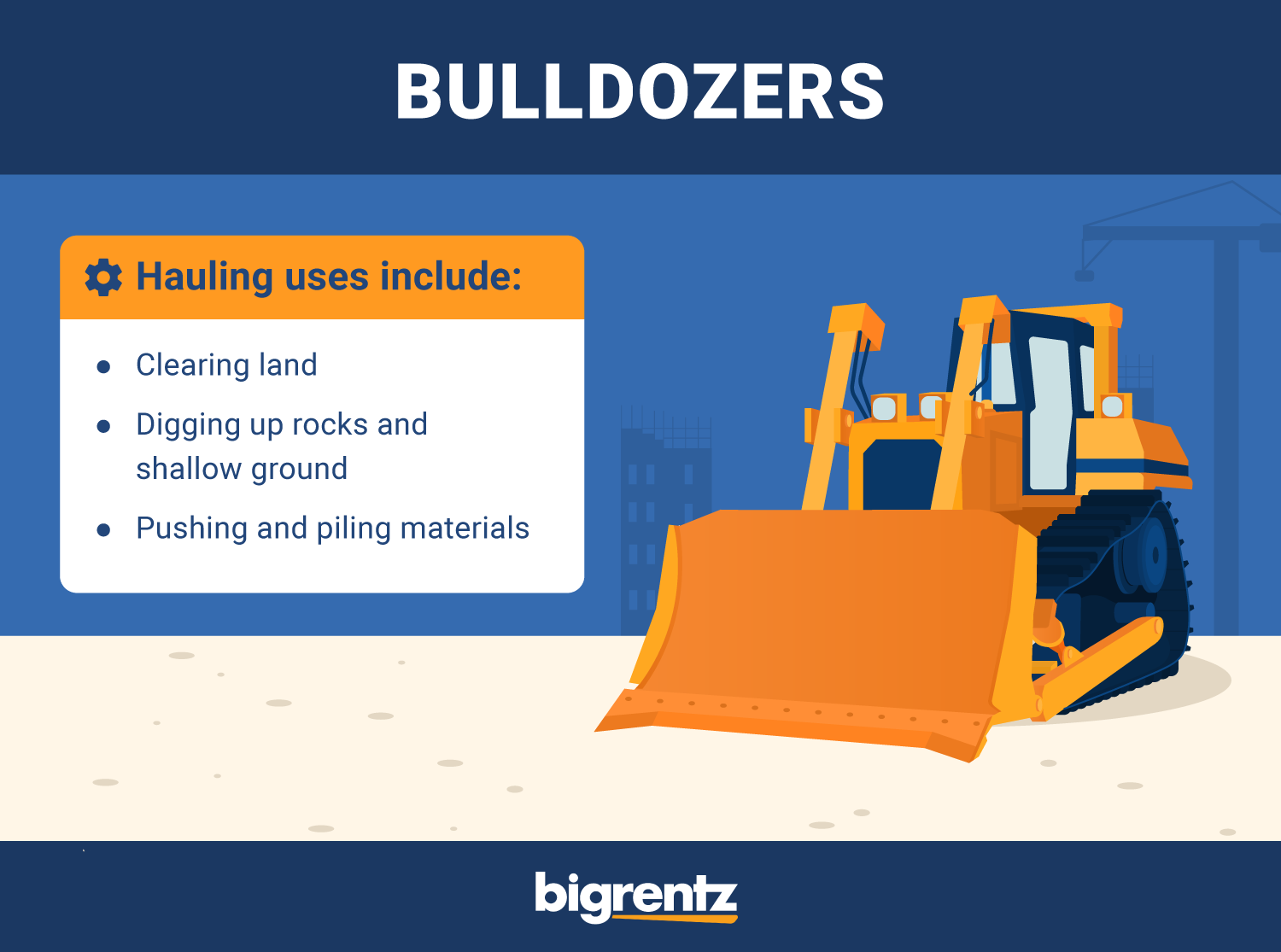
The smallest bulldozers move about 2.1 cubic yards of dirt and dig about 2 feet, while large standard models can handle over 50 cubic yards. The largest bulldozers, typically used for mining purposes, can push up to 90 cubic yards. Basically, bigger machines can handle heavier loads.
The cost to rent a bulldozer ranges as follows, though prices can fluctuate based on factors like location and availability:
- 70–79 hp bulldozer: $468/day, $1,154/week, $3,549/month
- 90–99 hp bulldozer: $537/day, $1,549/week, $4,520/month
2. Cranes
Explore All Cranes
Cranes are used to lift and move materials, particularly heavy loads. In fact, they’re often the first machine people think of when considering heavy hauling equipment. You can choose from many different types of cranes that are designed for specific purposes.
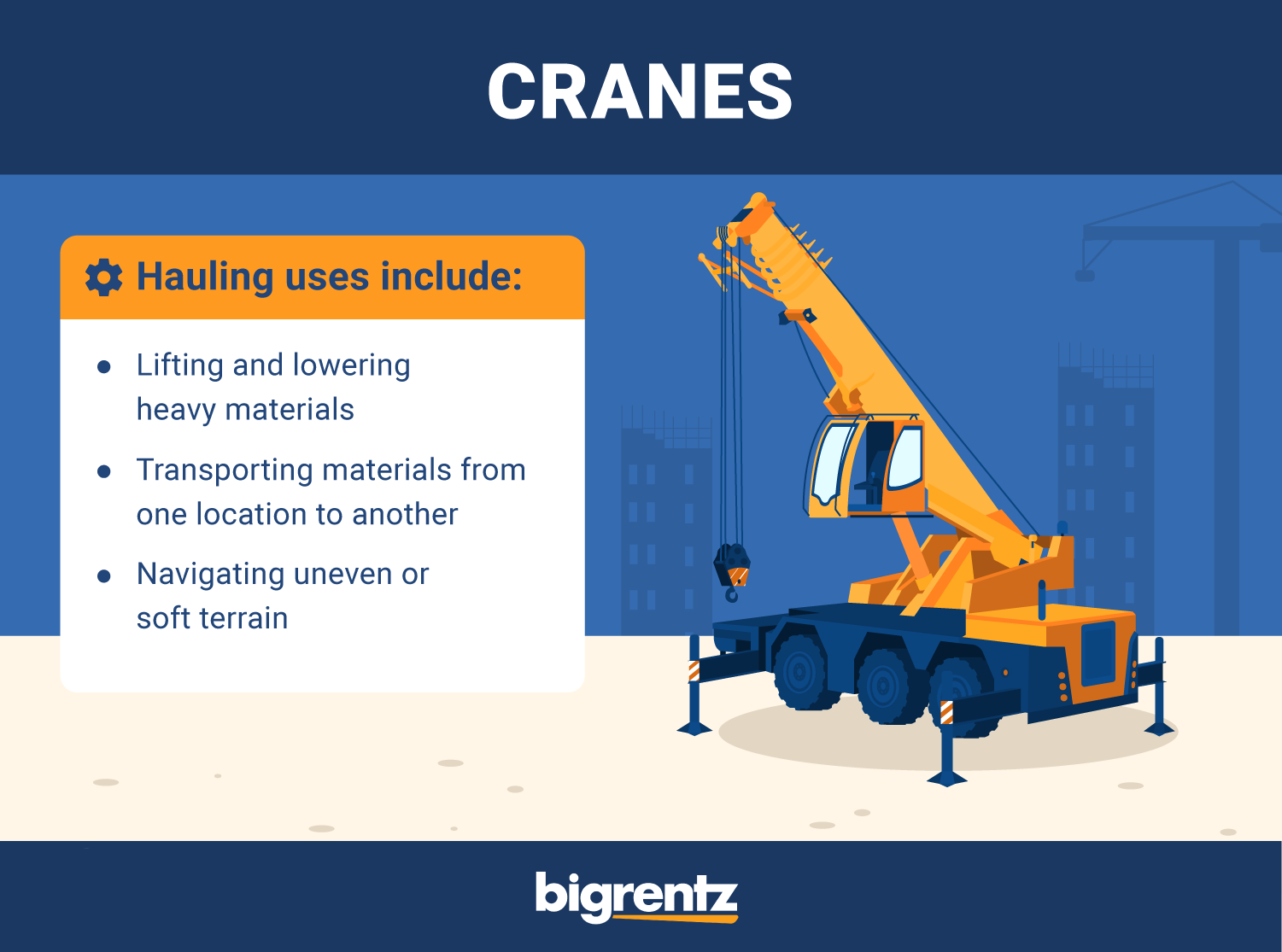
Mobile cranes, for example, offer more mobility than the standard crane, making it easier to load and move materials on and across construction sites. Tower cranes, on the other hand, are fixed cranes, but have the stability to handle heavier loads, making them ideal for work in building large structures. Rough-terrain cranes function well on uneven surfaces, such as off-road sites.
Load capacities also vary based on the type and model of crane you’re using. Liebherr mobile cranes (LTM 1030-2.1 to LTM 1110-5.2) have engine powers ranging from 280 horsepower to 544 horsepower and capacities from 40 U.S. tons to 125 U.S. tons. The cost to rent a crane also varies.
Cranes help in hauling projects by raising, lowering, lifting, and transporting heavy materials and objects on a construction site. But different crane types serve specific purposes in hauling applications. For example:
- Carry deck cranes, a type of mobile crane, have wheels and can drive to and from different locations to load and move materials.
- Crawler cranes, another mobile crane, have tracks to work on uneven or soft terrain.
- Rough-terrain cranes are best for soft terrain to move and load heavy materials.
- Tower cranes offer immense on-site lifting, handling heavy loads with ease, and they remain in a fixed, stable position until the job is done.
3. Excavators
Explore All Excavators
Excavators are a type of heavy-duty material handling equipment built to dig deep holes, demolish land, and lift heavy materials or debris. They’re useful in a variety of construction projects, especially mining.
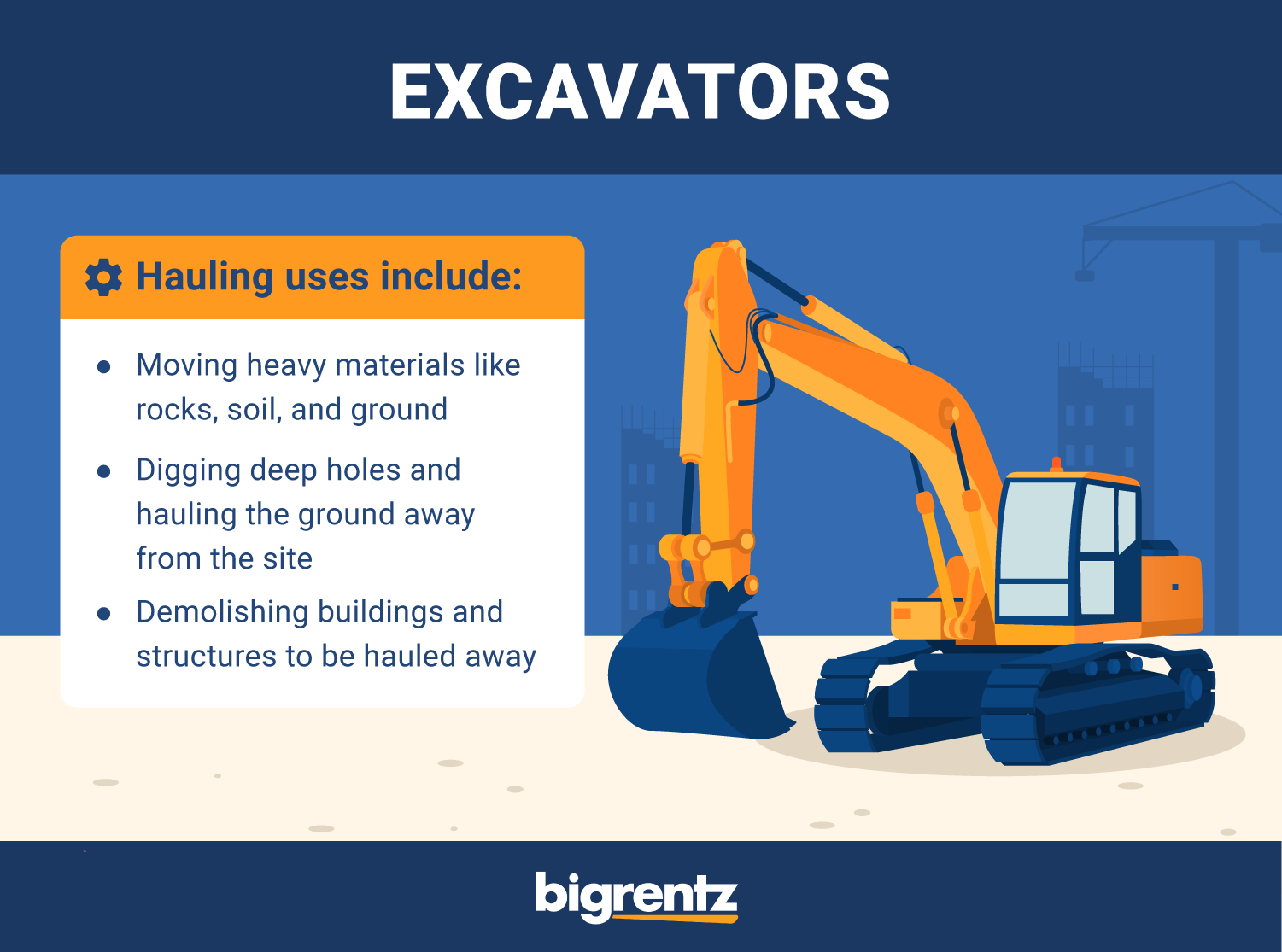
Case excavators (CX140E to CX750D ME) range in power from 102 horsepower to 512 horsepower. Their maximum lift capacity is 18,600 pounds to 74,600 pounds and maximum digging depth is 19 feet and 10 inches to 24 feet and 2 inches.
The cost to rent an excavator ranges as follows:
- 20,000–24,999 lb excavator: $352/day, $1,304/week, $3,826/month
- 50,000–59,000 lb excavator: $714/day, $2,185/week, $6,375/month
4. Loaders
Explore All Wheel Loaders
As the name suggests, a loader is a piece of heavy machinery used to move or load materials into or onto another piece of construction equipment or between locations. Different types of loaders have different specialties.
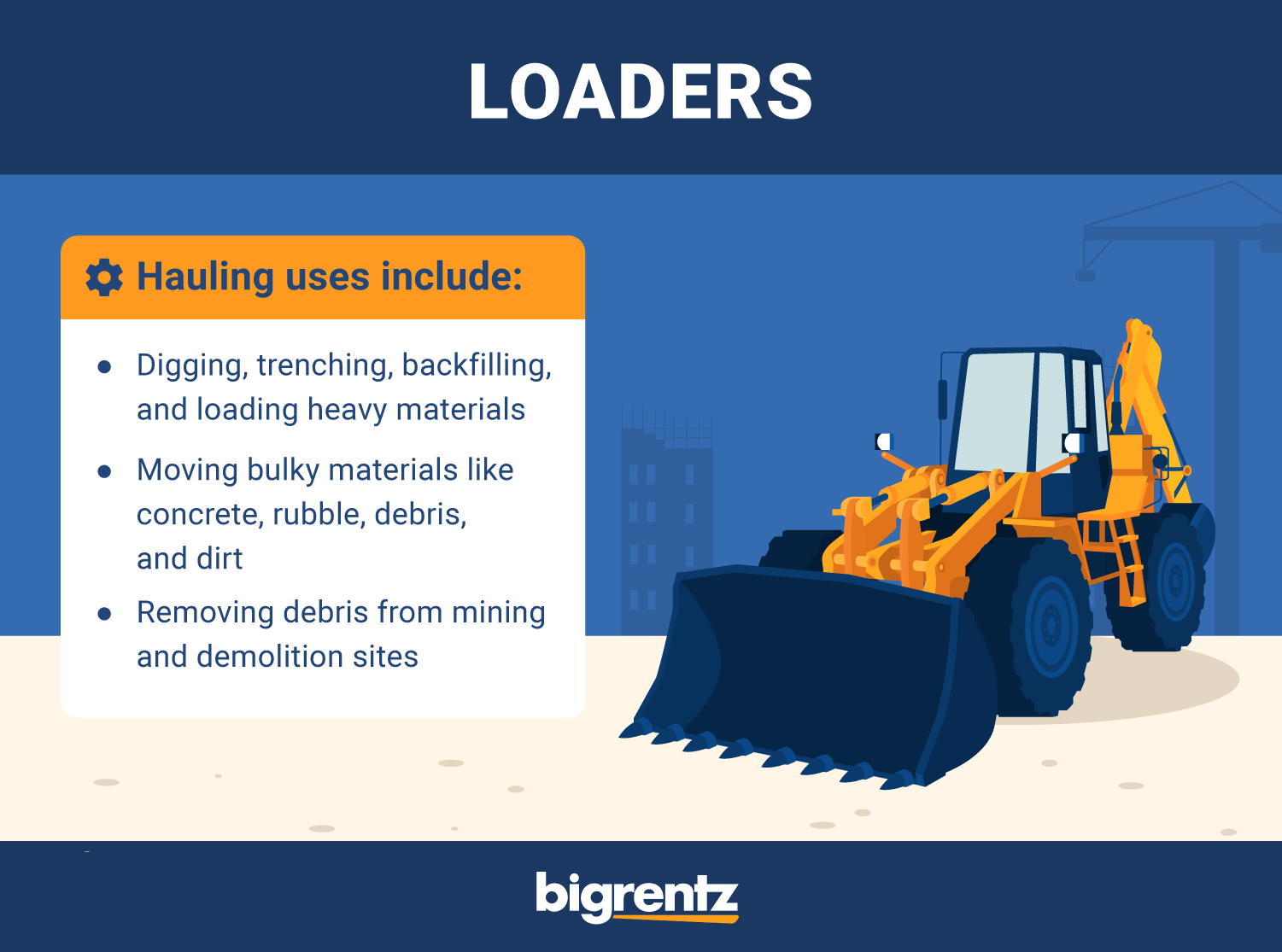
Backhoe loaders have a digging bucket in the front and are best for digging, trenching, backfilling, and loading. They can move bulky materials like concrete, rubble, and demolition debris.
Wheel loaders transport heavy materials like dirt, rubble, and debris. Their tires allow them to work on road surfaces as well as in agricultural, waste management, and mining sites.
Track loaders are ideal for construction tasks on uneven ground and can have many attachment options, making them versatile machines for grading, excavation, drilling, and demolition. They also work well in tight spaces in applications like landscaping and site development.
The cost to rent a loader depends on the type. Here’s how rental costs break down.
Backhoe loader rental cost:
- 20–59 hp mini backhoe: $229/day, $651/week, $1,372/month
- 60–89 hp standard backhoe: $254/day, $881/week, $2,263/month
Wheel loader rental cost:
- 2 cu yd articulating wheel loader: $403/day, $1,187/week, $3,472/month
- 4 cu yd articulating wheel loader: $725/day, $2,143/week, $6,248/month
Skid steer loader rental cost:
- 1,000–1,999 lb track skid steer loader: $319/day, $896/week, $2,273/month
- 2,000–2,499 lb track skid steer loader: $365/day, $1,096/week, $2,858/month
5. Mining Shovels
Mining shovels are a type of heavy equipment designed for strip and surface mining. Their powerful shovels allow them to break through and excavate materials like hard soils and rock fragments. They can also be used to lift, load, and unload large, heavy materials.
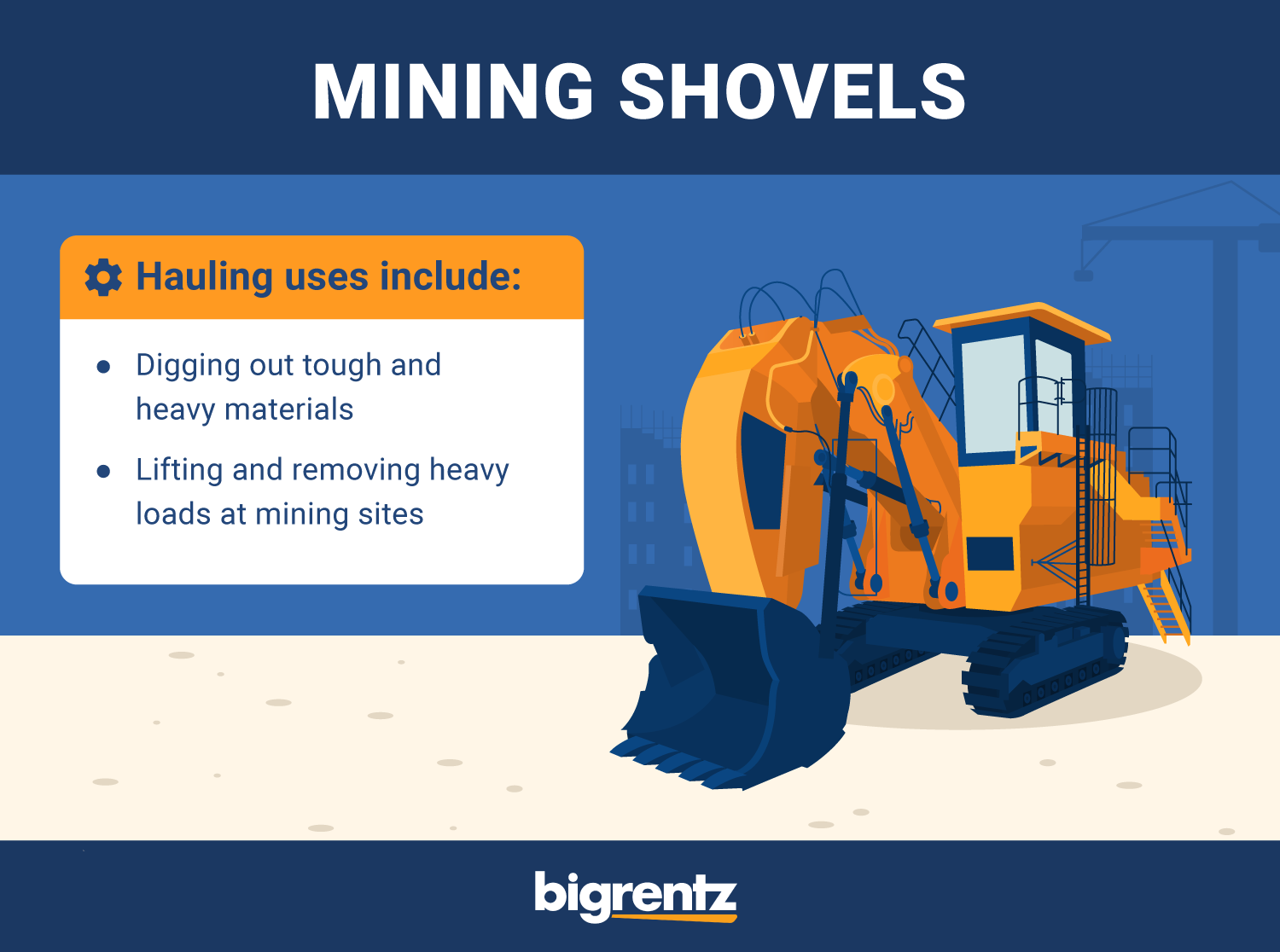
To give an example of their power and capacity, Komatsu mining shovels (1900XPC to P&H 4800XPC) range in nominal payload from 280 pounds to 1,890 pounds and dipper capacity from 14 cubic yards to 92 cubic yards.
Similar to other types of hauling equipment, the cost to rent a mining shovel can vary based on type, model, and your rental needs.
6. Compact Tractors
Explore All Skip Loaders
Compact tractors are multi-utility vehicles that give you high tractive effort at low speeds to haul heavy loads across various types of terrain. With the right attachments, you can use these versatile pieces of equipment to push, pull, and even lift heavy loads.
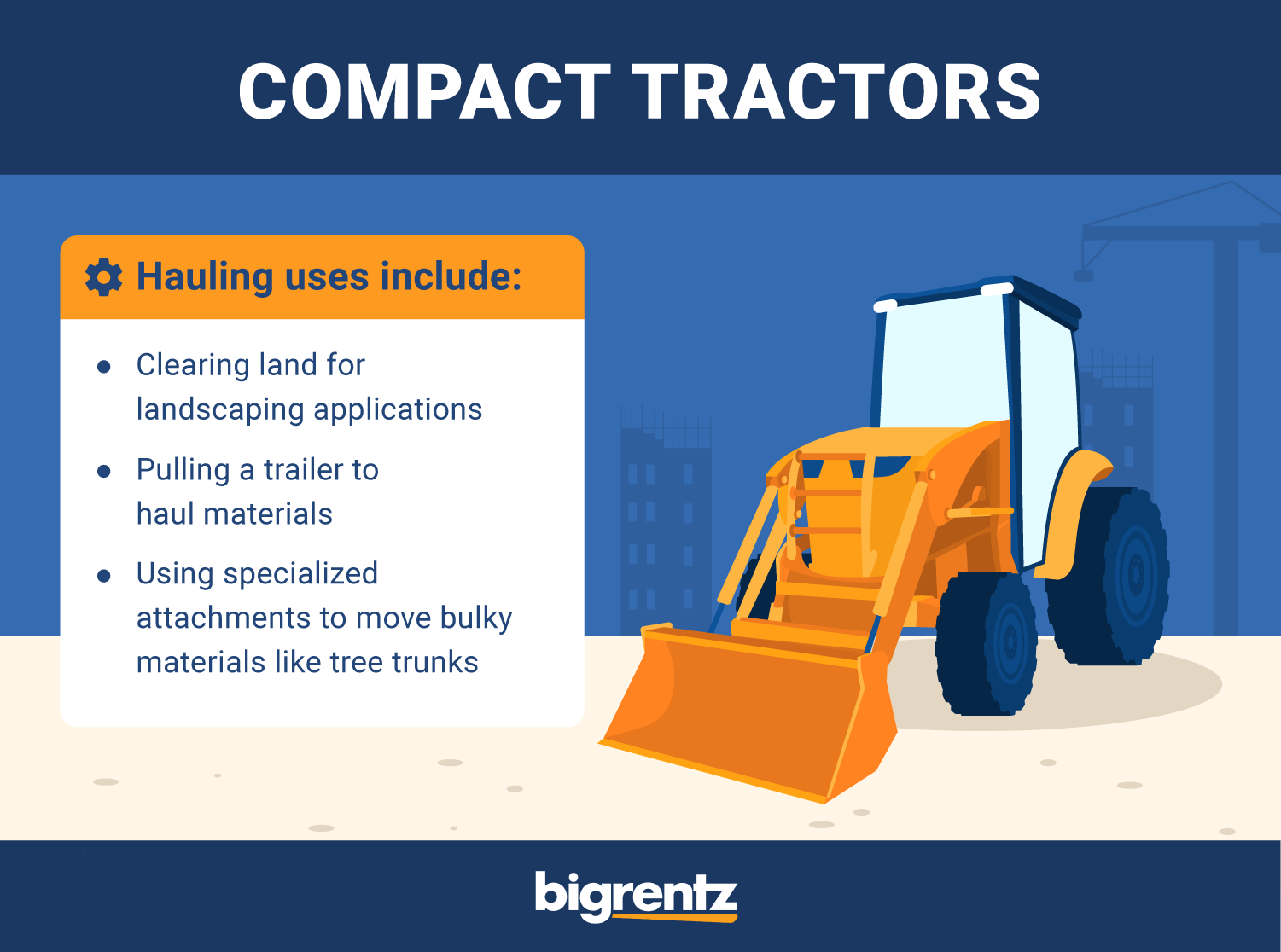
As an example of their power and capacity, John Deere compact tractors (Series 1 through Series 4) range in power from 21.5 horsepower to 75 horsepower and have loader lift capacities ranging from 754 pounds to 2,222 pounds. Rental costs can vary based on a variety of factors, including what you need in terms of size, how long you need it, your location, and equipment availability.
7. Trucks
Hauling trucks, like dump trucks and flatbed trucks, are a great option for transporting materials. Depending on what material you’re working with and the project’s needs, you may find that one type of truck works better than another.
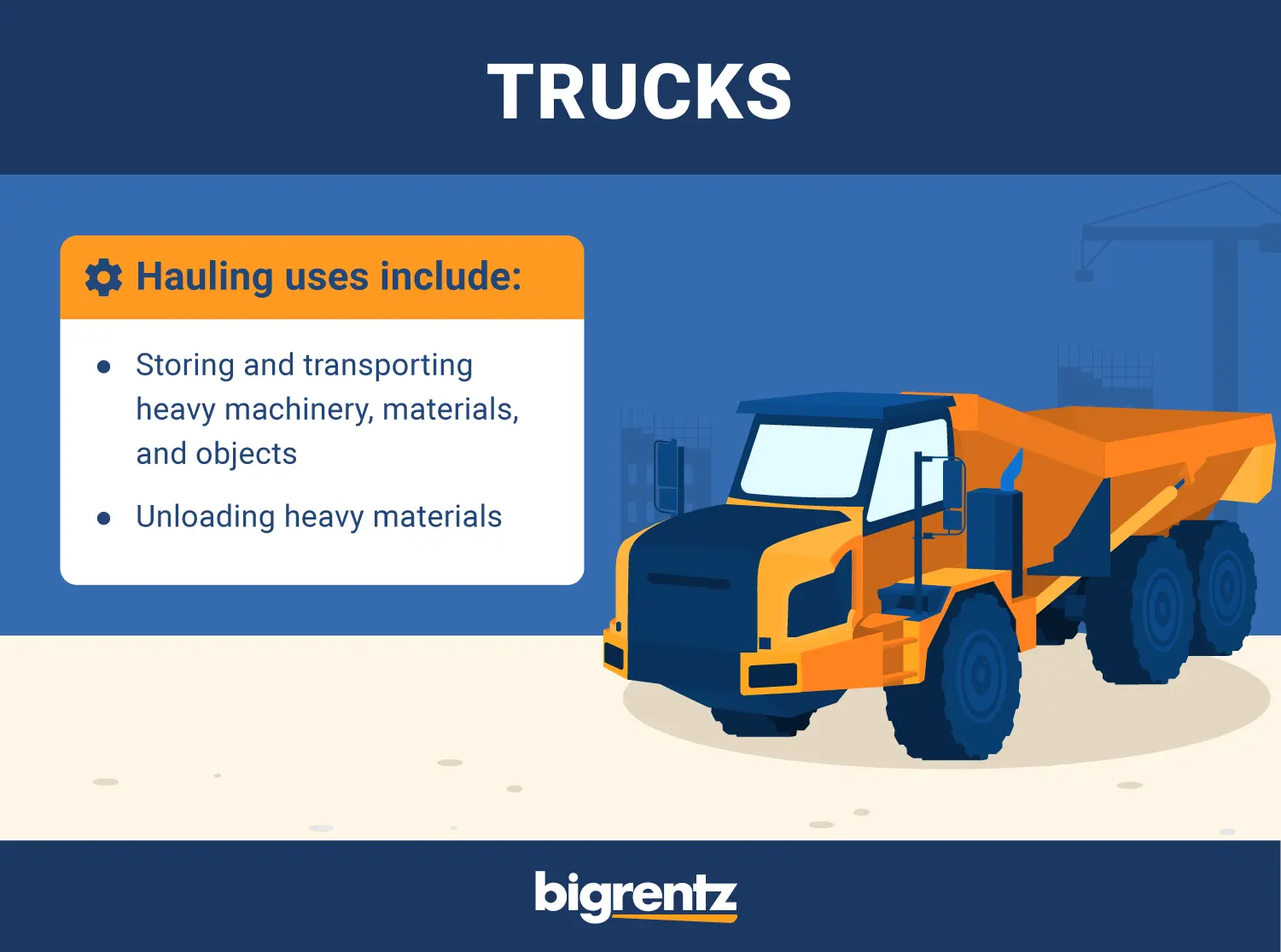
You can use dump trucks to transport a lot of material at once, and you’ll find dump trucks work best when hauling loose materials like gravel, soil, and debris from demolition and mining projects. You may prefer using flatbed trucks to haul things like scrap metal and building materials, but you can also use them to carry heavy machinery, bales, and cargo. The cost to rent a truck varies depending on the type of truck you need and other factors related to the job.
Whether you need to haul a little or a lot, Komatsu dump trucks (HM300-5 to 980E-5SE) can meet a variety of needs since they range in power from 332 horsepower to 4,400 horsepower and in payload from 30.9 U.S. tons to 400 U.S. tons. Their heaped capacity ranges from 22.4 cubic yards to 327 cubic yards.
Tips For Using Hauling Equipment
Hauling equipment is a necessary part of many construction projects, and it’s important to go about using it the right way. You can consider the following tips to ensure you’re hauling equipment is used safely and efficiently:
- Know your load before you rent. Before renting equipment, you should measure the length, height, and width of your load. Measuring the load and load capacity not only ensures you know what you’ll be hauling, but it also helps you select the right equipment that can carry the load.
- Obtain the permits you need. Each state has specific requirements for hauling equipment and material, so be sure you get the necessary permits for hauling.
- Secure the load. From debris flying out of a dump truck to strapping your load tightly to a flatbed, you need to both protect the load and anyone around it. So make sure you properly secure the load to avoid injuries or damaging loads.
- Drive carefully. Even with a secure load, you can’t take risks while driving. You should always drive with care when transporting and hauling materials from site to site.
- Follow the law. When transporting heavy loads on roadways, you should carefully follow all laws and regulations related to driving and hauling materials.
Which Type of Hauling Equipment Do I Need?
When you’re ready to rent hauling equipment, the right machine can vary depending on your needs. So you have to assess the specifics of your job, such as the load you need to haul, and you need to take into account the size and shape of the material, the terrain you’ll be on, and how far you need to transport the materials.
You can use this quick summary of the equipment in this post, to help narrow down your need by taking their applications and capacities into consideration:
- Bulldozers: You can use these heavy haulers for a variety of applications, from mining to construction, depending on the size of the bulldozer. If you need to move about 2.1 cubic yards of dirt, you might choose a smaller model, but select a standard model when you need to handle around 50 cubic yards. For bigger loads, the largest machines can handle up to 90 cubic yards. You can choose a model with tracks or wheels depending on your job site’s terrain.
- Cranes: You may need these machines when you need to lift and move materials in a variety of sites. Choose from fixed types, like tower cranes, or movable ones, like mobile cranes. Load capacities can vary, but mobile cranes can typically handle from 40 to 125 tons.
- Excavators: If you need to dig, demolish, and lift, you’ll find excavators a useful machine as you can use them in a variety of construction and mining applications. A typical maximum lift capacity ranges from 18,600 pounds to 74,600 pounds.
- Loaders: Made for moving, hauling, loading, and unloading, you can find a loader to be helpful across a wide variety of applications, including construction, agriculture, forestry, mining, waste management, landscaping, and site development. Specific models work best in certain applications, and a typical loader’s power ranges from 69 horsepower to 148 horsepower.
- Mining shovels: Primarily used in surface and strip mining, you’ll find these machines to be adept at breaking through and removing harder materials. Payload typically ranges from 280 pounds to 1,890 pounds.
- Compact tractors: Used primarily in landscaping, agriculture, and mining, use a compact tractor to push, pull, and lift heavy loads. A standard tractor ranges in power from 21.5 horsepower to 75 horsepower and has a lift capacity ranging from 754 pounds to 2,222 pounds.
- Trucks: Perhaps the most universally used vehicle on the list, you can find uses for trucks in almost any application. Power and load capacities vary depending on the type and model you’re using, but, for example, a typical dump truck can range in payload from 30.9 U.S. tons to 400 U.S. tons.
Ready to Rent?
Keeping your worksite safe and running efficiently means finding the right hauling equipment for your specific task. When searching for the best hauler, make sure you keep your specific needs in mind and choose the type of equipment that matches them best.
From bulldozers and cranes to excavators and loaders, BigRentz has all your equipment rental needs covered. Rent the equipment you need today, so you can get hauling!
Explore All Earthmoving Equipment